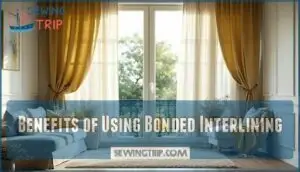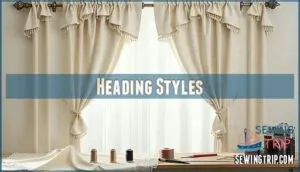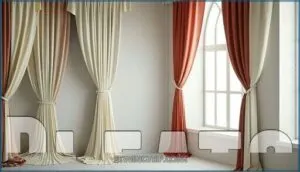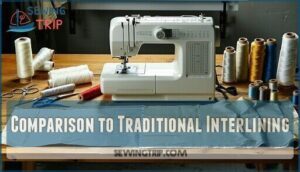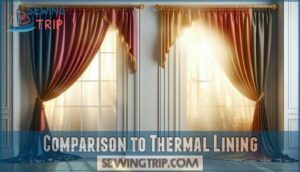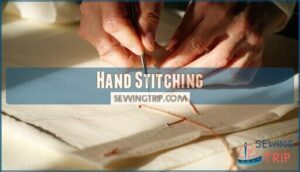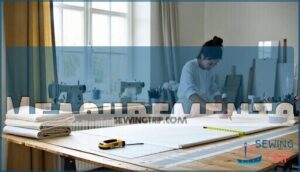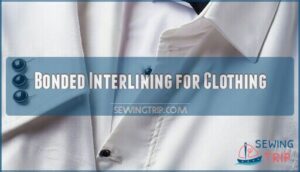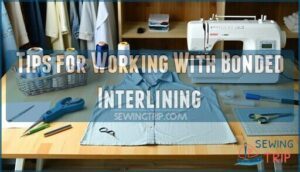This site is supported by our readers. We may earn a commission, at no cost to you, if you purchase through links.
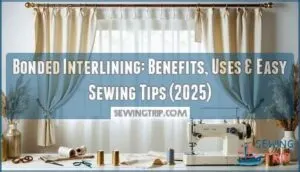
You’ll find it’s usually made from cotton or cotton blends and comes pre-treated with adhesive backing. This interlining transforms ordinary curtains into professional-grade window treatments by adding structure, weight, and thermal properties.
It’s different from regular interlining because it bonds permanently to your fabric, eliminating the need for separate stitching layers together. The bonding process creates a unified fabric that won’t shift or bunch over time.
Beyond curtains, you can use bonded interlining in clothing for structured collars and sleeves, giving garments that crisp, custom finish that screams quality craftsmanship.
Table Of Contents
- Key Takeaways
- What is Bonded Interlining?
- Benefits of Using Bonded Interlining
- Using Bonded Interlining for Curtains
- Comparison to Traditional Interlining
- Comparison to Thermal Lining
- Sewing With Bonded Interlining
- Bonded Interlining for Clothing
- Tips for Working With Bonded Interlining
- Frequently Asked Questions (FAQs)
- Conclusion
Key Takeaways
- You’ll get superior insulation and energy savings – Bonded interlining reduces heat loss by 15-40% and can cut your energy bills by up to 10%, making it a smart investment for year-round comfort.
- You’re buying durability and UV protection – This material shields your curtains from harmful UV rays, keeping colors vibrant for 5+ years instead of fading within 2-3 years like unprotected fabrics.
- You’ll achieve professional-grade structure – The pre-bonded layers eliminate shifting and bunching while creating fuller, more structured drapes that maintain their shape over time without separate stitching.
- You can use it beyond curtains for structured garments – Apply bonded interlining to shirt collars, sleeves, and other clothing elements where you need crisp lines and professional finishes that resist collapse through washing.
What is Bonded Interlining?
Bonded interlining combines two fabric layers into one unified material, simplifying your sewing process.
This textile bonding creates fabric reinforcement that’s stronger than traditional interfacing fabric alone.
You’ll find bonded materials featuring cotton sateen paired with interlining types like fleece or wadding.
The fabric thickness varies from lightweight to heavy, affecting fabric durability and final appearance.
Unlike fusible interfacing that requires heat application, bonded interlining comes pre-attached.
These sewing techniques reduce construction steps while maintaining professional results in both curtains and garments, utilizing textile bonding for improved outcomes.
Benefits of Using Bonded Interlining
You’ll find bonded interlining offers three major advantages that make it worth the extra investment.
This fabric combination provides superior insulation, blocks harmful UV rays, and creates beautifully structured drapes.
That transform any window treatment, making it a valuable addition to any space, with the added benefit of beautifully structured drapes.
Insulation
When winter arrives, your curtains become silent guardians against energy loss.
Thermal insulation from bonded interlining creates an effective insulation barrier that boosts heat retention by up to 40%. This thermal barrier delivers measurable energy savings through superior heat regulation and climate control.
Beyond cold prevention, the dense structure provides soundproofing benefits.
Key thermal benefits include:
- Reduces heat loss by 15-25% during winter months
- Maintains 3-5°C temperature difference between indoor/outdoor extremes
- Achieves R-values ranging from 0.5 to 1.2 for peak performance
- Delivers up to 10% energy savings in well-insulated homes
- Provides year-round temperature regulation for consistent comfort
UV Protection
Three essential benefits make UV protection your fabric’s best friend.
Bonded interlining acts as sunscreen fabrics, creating protective layers that shield against harmful solar radiation.
This solar guard technology extends fabric life substantially.
| Without UV Protection | With Bonded Interlining |
|---|---|
| Fading within 2-3 years | Colors stay vibrant 5+ years |
| Fabric weakening | Enhanced UV resistance |
| Frequent replacements | Long-term fabric protection |
Your curtains deserve this UV resistance investment for lasting beauty and durability.
Drape
When you’re working with fabric fullness, bonded interlining transforms your curtain styles into something spectacular.
This clever combination enhances drape quality while maintaining the perfect fabric weight for professional drapery results.
Here’s how bonded interlining improves curtain drape:
- Enhanced fabric drape – Creates natural, flowing movement
- Improved texture effects – Adds body without stiffness
- Better fold techniques – Maintains crisp, even pleats
- Drape preservation – Keeps shape over time
- Consistent fabric weight – Balances heavy and light materials
Understanding fabric drape basics is essential for achieving the desired movement and flow in your curtains.
Using Bonded Interlining for Curtains
When you’re making curtains with bonded interlining, you’ll need to choose the right heading style and pleat technique to achieve your desired look.
The bonded structure provides excellent support for various pleat styles, from crisp pinch pleats to soft hand-sewn gathers, while maintaining the fabric’s shape and drape.
Heading Styles
Seven fundamental heading styles will transform your curtain’s appearance and functionality when paired with bonded interlining.
- Pinch pleat tape creates crisp, precision-crafted pleats with consistent spacing
- Buckram adds body and structure for smooth, rounded curtain heads
- Goblet heading offers elegant, cup-shaped fold techniques for drape effects
- Wave variations provide modern pleat types perfect for blind fittings
Each heading style works seamlessly with bonded interlining to enhance your curtain’s professional finish and structural integrity.
Understanding the proper use of interlining materials is vital for achieving superior results in curtain making.
Pleats
How do you achieve professional-looking pleats with bonded interlining? Start by selecting your pleat styles based on desired fullness and aesthetics.
Pinch pleat tape creates uniform spacing, while goblet pleats offer soft movement at 50-100% fullness. Accordion pleats provide crisp stacking, inverted pleats add depth, and knife pleats deliver sharp lines.
Consider pleat depth when choosing fabric – heavier bonded interlining supports deeper folds. Pin each pleat individually before securing with your preferred sewing methods to maintain consistent fold techniques throughout your curtain project.
To guarantee accurate fabric cuts, consider the fabric cutting guide for your curtain projects.
Comparison to Traditional Interlining
Choosing between bonded and traditional interlining affects your project’s final appearance and functionality.
Traditional interlining uses single-layer cotton or flannel that’s separately cut and basted to fabric. This construction method allows independent layer movement, creating softer drape.
Understanding the role of lining fabric types is essential for selecting the right interlining for your project.
| Feature | Traditional Interlining | Bonded Interlining |
|---|---|---|
| Construction Methods | Hand-basted layers | Heat-fused adhesive |
| Fabric Thickness | Single cotton layer | Multi-layer composite |
| Weight Difference | Lighter, more flexible | Heavier, more structured |
Material comparison reveals bonded wadding provides superior durability through fusion processes. Traditional interlining offers natural fiber benefits but requires careful handling.
Interlining types vary in weight difference and fabric interlining properties. For blackout interlining applications, bonded varieties maintain consistent light-blocking performance. Your choice depends on desired structure versus softness.
Comparison to Thermal Lining
Understanding thermal lining versus bonded interlining requires examining their fundamental differences in construction and performance. Thermal lining typically features a single-layer design with moderate insulation properties, while bonded interlining combines multiple layers permanently fused together.
| Feature | Thermal Lining | Bonded Interlining |
|---|---|---|
| Insulation | 22-25% heat reduction | 35-40% heat reduction |
| Light Blocking | 60-80% | 80-99% |
| Fabric Thickness | Lightweight, flexible | Heavier, structured |
| Energy Efficiency | Moderate savings | Up to 10% energy savings |
The fabric thickness difference substantially impacts drape behavior. Thermal linings maintain fluid movement and soft folds, making them ideal for casual window treatments. Bonded interlining’s structured nature creates fuller, more formal appearances with superior pleat retention.
Lining materials also affect maintenance requirements. Thermal linings often allow machine washing, while bonded wadding typically requires dry cleaning. For blackout lining applications requiring maximum light control and fabric insulation, bonded interlining delivers superior performance through advanced textile science principles. The choice between lining and underlining techniques is vital for achieving the desired texture and appearance in garments.
Sewing With Bonded Interlining
Working with bonded interlining requires careful attention to hand stitching techniques and precise measurements for professional results.
You’ll need to master slip stitching and catch stitching while measuring twice before cutting to guarantee your curtains hang beautifully.
Hand Stitching
When tackling hand stitching with bonded interlining, proper fabric preparation sets you up for success. Start by securing your interfacing to the main fabric using appropriate stitch techniques that won’t create bulk or puckering.
For hand sewing, select a sharp needle that glides through multiple fabric layers without forcing. Choose thread that matches your fabric weight—lightweight cotton thread works well for most bonded interlining projects.
A slip stitch creates nearly invisible seams along hems and side edges, while catch stitching every few inches adds reinforcement without sacrificing drape. Work slowly through each seam, maintaining even tension to prevent thread breakage.
Your needle choices matter here—a size 9 or 11 universal needle handles most bonded fabrics smoothly. Keep stitches small and consistent, securing threads within seam allowances to maintain clean finished edges.
These hand stitching methods preserve the fabric’s natural movement while creating professional-looking results that machine stitching often can’t match.
Measurements
Precise measurements make the difference between professional-looking curtains and costly mistakes when working with bonded interlining.
Start by measuring your window’s width and length twice to guarantee accuracy. Add seam allowances of 10cm for side hems and calculate the required fabric width by dividing your total curtain width by the available fabric width. For curtain measurements, include 15cm for heading and hem depth in your drop calculations.
Consider these essential measurement steps:
- Measure fabric width against your window dimensions plus fullness requirements
- Calculate thread count compatibility with your chosen bonded interlining weight
- Mark precise measurements with chalk before cutting to prevent errors
- Account for hem depth and seam allowance in all fold measurements
Accurate fabric measurement prevents waste and helps your bonded interlining align perfectly with your main fabric. To achieve superior results, understanding the interlining material properties is vital for selecting the right type of interlining for your project.
Bonded Interlining for Clothing
You’ll find bonded interlining most commonly in clothing construction where structure and support matter most.
This fabric composite works particularly well in collars and sleeves, where it maintains crisp lines and professional finishes that regular fabrics can’t achieve alone, providing a key element of professional finishes.
Collars
Moving from general sewing techniques to specific garment applications, let’s examine how bonded interlining transforms shirt collars. Bonded interlining provides critical collar support by adding structure without excessive bulk. You’ll achieve prime collar stiffness using light to midweight fusible products.
Cut interlining on the bias, applying adhesive to the wrong side before fusing to the collar’s underlayer. These stiffening methods create sharp collar shapes that resist collapse through repeated washing. Professional tailoring materials like cotton voile maintain softness while providing necessary structure.
Focus adhesive application on collar points for enhanced definition. Proper application of interlining and adhesive is crucial for achieving the desired collar shape and maintaining its structure over time.
| Collar Type | Interlining Weight | Key Benefit |
|---|---|---|
| Dress shirt | Light to midweight | Maintains crisp appearance |
| Casual shirt | Lightweight | Comfort with structure |
| Work uniform | Midweight | Durability through laundering |
| Fashion collar | Variable | Sculpted, custom silhouettes |
| Semi-spread | Medium | Sharp edges, pronounced points |
Proper interfacing in garment construction guarantees your collars maintain their intended shape and professional appearance throughout the shirt’s lifespan.
Sleeves
Bonded interlining transforms sleeve construction by providing essential armhole support and controlled sleeve stiffness.
This tailoring material helps maintain your garment’s professional shape through countless wears. Over 80% of quality suits rely on this interfacing technique for structured sleeves.
When choosing fabric for sleeve applications, consider the balance between support and flexibility. Light-to-medium weight bonded interlining works best for dress shirts, while heavier options suit formal jackets.
Your sewing techniques should accommodate the added bulk at seam intersections. Different interfacing types offer varying levels of structure.
Cut your interlining slightly smaller than the sleeve pattern to prevent puckering during garment construction. This approach guarantees clean, professional results in clothing applications while maintaining the custom look you want.
Tips for Working With Bonded Interlining
Working with bonded interlining requires attention to fabric selection and proper sewing techniques. Choose polyester-cotton blends in 150-250gsm weights for ideal drape and thermal properties. Cut interlining slightly smaller than your main fabric to prevent puckering during assembly.
Understanding interlining fabric properties is vital for selecting the right materials.
Essential techniques for professional results:
- Use sharp rotary cutters to prevent fraying of bonded edges
- Pre-press with medium heat to stabilize before stitching
- Select 90/14 needles with polyester thread for durability
- Baste layers together before final seaming for accurate alignment
- Store rolled, never folded, to avoid permanent creases
Frequently Asked Questions (FAQs)
What’s the difference between lined and interlined curtains?
Lined curtains have a single backing layer for privacy and light control.
Interlined curtains include an extra insulating layer between the main fabric and lining, creating fuller drape, better insulation, and enhanced structure.
Is interlining worth it?
Yes, interlining’s definitely worth it if you want professional-looking curtains with better insulation and fullness.
It’ll boost your curtains’ thermal performance by 25%, enhance drape quality, and protect fabrics from UV damage for longer-lasting results, which will also enhance overall curtain quality.
What are the different types of interlining?
You’ll find several interlining types to suit your project needs.
Cotton sateen offers excellent drape, while polyester blends provide durability.
Lightweight options work for delicate fabrics, heavy versions add structure.
Some include adhesive backing for easy application.
How to join bonded interlining?
Like threading a needle through layers of fabric, joining bonded interlining requires careful stitching.
Use flat-fell seams or overlapped edges with zigzag stitches.
Apply gentle pressure when pressing seams to avoid separating the bonded layers underneath.
How much does bonded interlining cost?
Bonded interlining typically costs £99-£99 per meter in the UK. You’ll find variations based on quality and features, with premium options costing slightly more than basic versions for your projects.
Can bonded interlining be machine washed?
Threading your sewing needle becomes easier when you know the right technique.
Machine wash cold, delicate, tumble dry low works well for bonded interlining.
Test a small piece first to verify it won’t shrink or lose its bonding strength, ensuring that the technique is effective.
Where to buy bonded interlining fabric?
You’ll find bonded interlining at fabric stores like Jo-Ann Fabrics, online retailers such as Amazon and Fabric.com, or specialty home décor suppliers.
Check local upholstery shops too—they often stock quality options for curtain projects.
What weight bonded interlining should I choose?
Choose light to medium weight bonded interlining for most curtains.
Heavy fabrics need thicker options, while delicate materials work best with lightweight versions.
Consider your room’s thermal needs—thicker provides better insulation.
Is bonded interlining suitable for outdoor use?
Looking to weather the elements with your window treatments?
Standard bonded interlining isn’t designed for outdoor exposure.
UV rays, moisture, and temperature extremes will quickly degrade the adhesive bonds and fabric fibers, causing separation and deterioration within months of exposure.
Conclusion
Consider a luxury hotel that switched from basic curtains to bonded interlining treatments.
Their energy costs dropped 15% while guest satisfaction scores increased due to better room darkening and temperature control.
Understanding what’s bonded interlining offers you significant advantages for any sewing project.
This versatile material combines structure, insulation, and professional results in one application.
Whether you’re creating premium window treatments or adding body to garments, bonded interlining delivers consistent performance.
You’ll achieve professional-grade results with less effort than traditional multi-layer methods.
Start small with a test project to experience how this material transforms your finished work quality.
- https://www.fusibleinterfacing.com/bonded-interlining/
- https://www.terrysfabrics.co.uk/blogs/curtain-fabric-buying-guide/how-much-fabric-do-i-need
- http://mysewingmall.blogspot.com/2016/11/interlining-101-knowing-and.html
- https://www.ben-interlining.com/blog/what-are-the-common-thicknesses-of-polyester-interlining-913569.html
- https://www.jobrowncurtainsandblinds.co.uk/blog/made-to-measure-roman-blinds-linings

